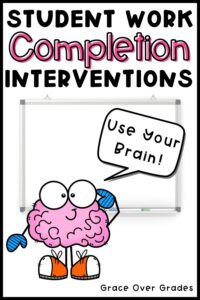
There’ s nothing more frustrating for elementary teachers than when you take the time to plan an engaging lesson and then have to convince a student to participate. When this behavior begins, it’s important to use the correct work refusal interventions, such as a student work completion chart, to put a stop to it quickly before it spirals and becomes a daily habit for that student.
But how?
In this article, we’ll share classroom management tips to improve work completion. You’ll receive a brief overview of the most common reasons elementary students struggle with work completion and work refusal intervention ideas for you to try in your own classroom.
✨Don’t miss the FREE INSTANT DOWNLOAD at the bottom of this article that you can start using in your classroom right away!✨
How to Stop the Student Work Refusal Spiral
The first, and most crucial step, is to find the WHY behind the behavior. If you don’t know why your student is behaving this way, you’ll never be able to choose the correct intervention to use with them. This is not a one-size-fits-all situation.
Top 6 Reasons Students Struggle with Work Completion:
- Distractions & Attention Difficulties
- Lack of Interest and Motivation
- Difficulty
- In Need of Emotional Regulation
- Issues Outside of the Classroom Walls
- Undiagnosed Disabilities
Work Refusal Interventions
1. Distractions & Attention Difficulties
I would venture to say that this is the most common reason elementary students struggle with work completion. No one really seems to know the why behind it, but our students’ attention spans are getting shorter and shorter by the day. This is why it’s so important to minimize distractions by providing a structured and calm learning environment.
Classroom Management Interventions: Ideas for supporting these students:
- Quiet classroom – play quiet instrumental music in the background
- Provide frequent breaks
- Provide visual cues such a an “If/Then” chart
- Keep close proximity for frequent verbal and nonverbal reminders
- Provide an individual student plan with small rewards to work toward
- Provide opportunities for movement to students who could benefit
2. Lack of Interest and Motivation
Even if you spent days planning the most engaging lesson, you’ll most likely still have trouble getting all of your students to fully participate. Some students just don’t have self-motivation for school work. This could stem from a home where school work isn’t valued. It could also come from a lack of maturity and a student who just wants to play and do the things that pleases him/her.
Classroom Management Interventions: Bottom line, YOU have to provide the motivation for these students in order to make work completion a habit. This most likely means providing a student work completion chart of some sort paired with positive reinforcement.
This will allow the student to set an achievable work completion goal. Once they meet that goal, they’ll enjoy the feeling of accomplishment and some sort of reward or recognition. If this is repeated enough times, these students will begin to form self-motivation to complete work.
3. Difficulty
Some students may struggle with work refusal because they’re overwhelmed by the work assigned. They might be finding aspects of the assignment difficult such as the particular content of the assignment or the confusing directions with too many steps.
Classroom Management Interventions: Ideas for supporting these students:
- Give visual supports such as a checklist of the assignment steps
- Assign a peer buddy to check-in with when they have questions
- Differentiate instructions to meet individual needs
- Break assignment into smaller chunks so it feels more manageable
4. In Need of Emotional Regulation
There are an unlimited number of reasons for your students feeling emotionally unregulated. A few examples are: worrying about what peers think, fear of failure or mistakes, overwhelmed with assignment (for any of the above reasons), upset from an unrelated situation.
Classroom Management Interventions: In this case, your number one priority is helping your student to regulate their emotions. Until they have a calm body and mind, they won’t be capable of completing their work – no matter how many supports you have in place. Some calming strategies to try:
- Go for walk or stretch your body
- Get a drink or snack
- Access the calming corner/calm space
- Use breathing exercises
- Take a few minutes to draw or color
5. Issues Outside of the Classroom Walls
It’s important for teachers to remember we have no idea what’s actually happening in our students’ homes. Even the most stable and supportive homes can be hit with issues outside of their control such as health problems, the loss of a job or divorce.
Our students may not KNOW what their families are dealing with, but they definitely FEEL the effects of it. This can leave our students feeling stressed, tired or having physical symptoms like stomach aches and headaches.
These factors will obviously affect a student’s ability to focus and complete work.
Classroom Management Interventions: If you suspect the work completion concerns might be stemming from factors outside of the classroom, it’s important for you to:
- Keep an open line of communication with your students and their families. Even if the parents don’t share home details with you, it’s important that they understand how their child is being affected by the situation.
- Collaborate with your school counself to offer support to the student and family.
6. Undiagnosed Disabilities
Elementary teachers are the first school contact for these children. We often come across undiagnosed disabilities and have to work closely with our building support educators to put a plan in place.
Another common factor is unaddressed disabilities due to families who aren’t ready to accept the diagnosis. We often think only of learning disabilities, but there are many other disabilities that can lead to student work refusal. Here are just a few:
- Learning Disabilities
- ADHD
- Anxiety
- Autism
- Sensory Processing Disorder
- Speech and Language Disorders
Work Completion Lesson & Work Refusal Interventions
It’s important that you have a plan in place for when this problem arises in your classroom. We’ve created a resource that provides everything you need!
Work Completion – Lesson & Interventions:
Work Completion Lesson (Members Only)
Strategy Posters (Members Only)
“If/Then” Chart (Members Only)
Student Reflection Page (FREE DOWNLOAD)
Work completion Charts (Members Only)
Teacher Documentation Chart (Members Only)
Did you know the Grace Over Grades Membership includes an entire year’s worth of classroom management lessons and behavior interventions for just $12.99?

Don’t forget to PIN this so other teachers can learn about these work refusal interventions and grab their own free download!

You might also enjoy reading Create Respect in a Classroom – ANY Classroom! or SEL Morning Meeting Questions.
